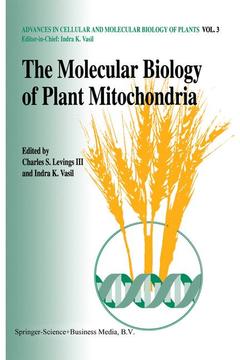The molecular biology of plant mitochondria, 1995 Advances in Cellular and Molecular Biology of Plants Series, Vol. 3
Langue : Anglais
Coordonnateurs : Levings, III Charles S., Vasil Indra K.

The double helix architecture of DNA was elucidated in 1953. Twenty years later, in 1973, the discovery of restriction enzymes helped to create recombi nant DNA molecules in vitro. The implications of these powerful and novel methods of molecular biology, and their potential in the genetic manipulation and improvement of microbes, plants and animals, became increasingly evi dent, and led to the birth of modern biotechnology. The first transgenic plants in which a bacterial gene had been stably integrated were produced in 1983, and by 1993 transgenic plants had been produced in all major crop species, including the cereals and the legumes. These remarkable achieve ments have resulted in the production of crops that are resistant to potent but environmentally safe herbicides, or to viral pathogens and insect pests. In other instances genes have been introduced that delay fruit ripening, or increase starch content, or cause male sterility. Most of these manipulations are based on the introduction of a single gene - generally of bacterial origi- that regulates an important monogenic trait, into the crop of choice. Many of the engineered crops are now under field trials and are expected to be commercially produced within the next few years. The early successes in plant biotechnology led to the realization that further molecular improvement of plants will require a thorough understanding of the molecular basis of plant development, and the identification and charac terization of genes that regulate agronomically important multi genic traits.
1. Mitochondrial genome organization.- 2. Mitochondrial plasmids: DNA and RNA.- 3. Mitochondrial transfer RNAs and RNA editing.- 4. Mitochondrial ribosomes and their proteins.- 5. Mitochondrial transcription and translation.- 6. Protein import into plant mitochondria.- 7. The biochemistry of the mitochondrial matrix.- 8. Bioenergetics: The mitochondrial electron transfer chain.- 9. Regulation of oxidative phosphorylation in plant mitochondria.- 10. The wheat mitochondrial genome.- 11. Mitochondrial genome of rice.- 12. S-type cytoplasmic male sterility in maize.- 13. The Texas male-sterile cytoplasm of maize.- 14. Cytoplasmic male sterility and organelle DNAs of sorghum.- 15. Cytoplasmic male sterility in Petunia.- 16. Cytoplasmic male sterility in Brassica species.- 17. Mitochondrial DNA in somatic hybrids and cybrids.- 18. Aberrant growth phenotypes associated with mitochondrial genome rearrangements in higher plants.- 19. The mitochondrial genome of a liverwort, Marchantia polymorpha.- 20. Mitochondrial evolution.- List of contributors.
Date de parution : 11-2012
Ouvrage de 673 p.
16x24 cm
Disponible chez l'éditeur (délai d'approvisionnement : 15 jours).
Prix indicatif 316,49 €
Ajouter au panierMots-clés :
© 2024 LAVOISIER S.A.S.



